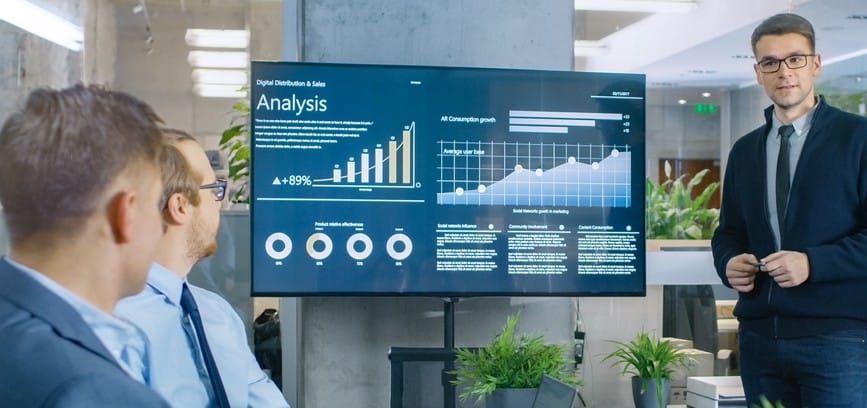
How workplace data can future-proof hybrid working environments

The future is workplace data
Never have we seen a bigger shake-up of the workplace as we have in the past two years. With that shake-up comes lots of uncertainty for commercial property owners. Business leaders want to substantiate the decisions they are making, ensuring that ultimate efficiency and usage of space is achieved and to do that, they want to make decisions backed by evidence. Enter workplace data.
Workplace data can help paint a picture for business leaders, allowing them to accurately analyse their needs and make constructive decisions upon understanding workplace functions. It also provides leaders with the necessary tools and insights to properly understand their organisation’s people and the future of work. With the help of data, you can minimise unnecessary expenditure and better understand where a business is going and what that will entail for things like space usage. This kind of intel allows businesses to be future-proofed and will help attract people back to commercial offices in a hybrid working model.
Here to offer his expertise is Alex Birch, co-founder and CEO of XY Sense - a company that offers smart, technology solutions that help organisations understand how well offices are being used by anonymously understanding human traffic in a space. Alex is an advocate for the power of data and believes it can positively transform the working dynamic, saying, “our aim is to provide quality insights which can be used for an optimally functioning workplace.”
The main data challenges holding workplaces back (and the solutions):
Privacy
Some people might be apprehensive about workplace monitoring and this may seem like a bit of a roadblock - but, it doesn’t have to be!
Alex says that this is where conversations need to happen. Highlighting the benefits of collecting workplace data, and how that will directly impact staff for the better, is essential. Transparency builds trust and that will make individuals feel not only valued but more inclined to be on board with thorough data collection. It’s important to recognise that gathering workplace data will only help the leadership team to better address and wholly understand the needs of their staff.
Alex also notes that “right from the outset, anonymity is the number one priority. We don't want to identify individuals, so there won’t be a system that's geared towards closely tracking people. It’s, in fact, the opposite. We speak about the friction that you see in a workplace. And our goal is to make it a better experience for people and make it easier for them to collaborate with their colleagues, find spaces that are safe and available, and to make it simpler for commercial real estate teams to provide the right amount and type of space for businesses. There's a real benefit in collecting that data.”
“If you don't have a lens into how the workplace is actually being used, then it's very hard for the real estate teams to do their jobs in providing a great experience for a business’ people.”
Collecting and presenting data
Sure, spreadsheets can be very useful to collate data, but you run the risk of human error when entering manually. Also, not storing the data correctly can be a big issue as it makes it harder to locate, share and use the information which is simply inefficient and can have detrimental effects on the quality of the information. Many companies now employ dashboard software which aggregates, itemises and self-analyses great quantities of data as an answer to this common problem.
More and more, companies need to be equipped to process large amounts of data. Alex highlights the importance of implementing smart data collection tools and strategies to ensure it’s accurate and trustworthy. “I would say that there's a certain level of information and insights you can get from your existing data set, but underpinning that is the accuracy of the data and how ubiquitous it is,” says Alex, “Does it cover all the different types of space, and for how long can you collect the data?”
“Other, more traditional data sets come from things like Wi-Fi, or batch data, and both of those give you information to a certain extent but they don't give you the accurate count of people. And once you've captured all that data you’ve got to figure out how it is presented and if you're capturing ongoing data.”
“That’s why exploring data options that provide insights on space usage accurately and frequently is instrumental. For example, human traffic data that’s captured every two seconds and, on average, per 37 centimetres - that gives you the level of accuracy you need to present the data in a way that's consumable, and has insights that can then be actionable. If you just present this usage, and you've got no way of disseminating that down into actionable insights, then that’s definitely an inhibition. So, accurate data is one thing, and actually having it distilled down into meaningful, usable insights is another.”  Data can really benefit the hybrid workplace
Data can really benefit the hybrid workplace
By using data to examine where and how employees are using spaces and their time, organisational leaders can employ analytics to understand the trends and working habits from pre through to post-pandemic and better inform hybrid workplace strategy, now and into the future. Accurate, evidence-based decisions can be made by putting data at the centre of organisations. It provides pure, uninhibited clarity on what is actually happening, further cementing its integral place in successful transitions to a hybrid workplace model.
Data can drive progressive, positive change in the hybrid working environment and be used for forecasting. As many people look to work between the home and the office, coordinating spaces can now be painless.
“In a hybrid world, there’ll be times where people would need to interact remotely and also be able to interact on-site, and sometimes with multiple people,” says Alex, “This speaks to the need for very different types of spaces and understanding that and the quantity of space is really important. Strategic data collection can help you do this, and workplace functioning should be, no doubt, underpinned by data.”
Workplace data can be immensely valuable in allowing CRE’s like yourself to properly cater to the needs of your organisation and people so you can have full confidence in returning to a safe and operative office space. Collecting data and actively synthesising it empowers you to be proactive in your decision making, better budget for change, and efficiently plan how to optimise functions for today and tomorrow.





